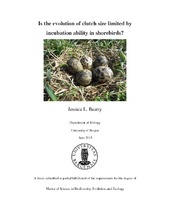Is the evolution of clutch size limited by incubation ability in shorebirds?
Master thesis
Permanent lenke
http://hdl.handle.net/1956/10278Utgivelsesdato
2015-06-01Metadata
Vis full innførselSamlinger
Sammendrag
Incubation is a crucial aspect of avian life history where differences in incubation techniques and investments can have long lasting effects on offspring and parental well- being and reproductive success. The factors limiting why some birds, such as shorebirds, have fixed clutch sizes has intrigued life history theorist to propose different hypotheses about the evolution of clutch size. Lack's "incubation limitation hypothesis," suggesting that clutch size is limited by the amount of eggs a parent can successfully cover during incubation, laid the foundation for many studies regarding clutch size evolution. The aim of this study was to investigate possible ways in which clutch size affects incubation temperature in shorebirds. To do so, I enlarged nests of Northern Lapwing Vanellus vanellus in Rogaland, Norway to five-egg clutches with control four-egg clutches of the same individual nest occurring for three-day periods per clutch size. Incubation temperatures were found to be significantly higher in enlarged clutches compared to natural-sized clutches indicating that incubation may be more efficient in enlarged clutches. However, this study was conducted over a small portion of the entire incubation period and I suspect that the high incubation temperatures in enlarged clutches found here, would not be maintained throughout the incubation period. I propose that costs to both parents and offspring associated with enlarged clutch size may outweigh potential reproductive benefits.
